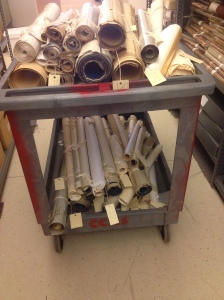On July 16 we shared a WHAT is it Wednesday artifact photo on Facebook to see if anyone could guess what it was.
We had some good guesses: a waterproof document case, a money belt, butcher’s sleeve, barber’s cloth…but no one guess correctly that this was a flag case! Two of our Wright State Public History graduate interns, Sara and Georgia, have spent the past week days going through the flags in our collection and assessing, providing care, and rewrapping and tagging them so that they are stored better. In one of the first boxes of flags, which contained Spanish American War era and Keifer Camp (GAR) flags, they came across this skinny leather case and were puzzled about its use. Luckily, Mel (an Army veteran and Civil War reenactor) was nearby and he recognized it right away as a flag case that is used to “case the colors” for a military unit when the unit is deactivated. It is traditional to hold a casing of the colors ceremony, which includes a reading of the history of the command, before the unit’s distinctive flag, or “colors,” are furled or “cased” in a protective sheath. The sheathed flag is then returned to the unit’s flag bearer, who marches off the field signaling the formal end of that command. We found a few recent pictures online of military units casing their colors to give you an idea of how the case was used. Unfortunately, this particular case does not have any information about how and when exactly it was used.

“Darkside” Marine Battalion, the most deployed battalion of the last decade, casing their colors, May, 2014.
One of the neatest finds over the past few days of flag wrapping was an ENORMOUS 38 star flag that was used from 1877-1890. It has holes along the top indicating that it was probably hung on the wall of a building in the area, but we are not sure about the details.

We wanted to share some pictures of Sara and Georgia working on the flags and we’ll be sharing their blog post on the experience later!
In the archives in our “Miscellaneous Military” collection we found a few other neat things on flag including a 1976 booklet on historic flags that was distributed by Big Bear Grocery for the Bicentennial, a Revolutionary Flag coloring book, also from the Bicentennial, and a page from a booklet on flag history about how to display the flag. We have several flags on display in the museum, including the 110th regimental flag from the Civil War, General J. Warren Keifer’s Headquarters flag from 1863, seen here.


















